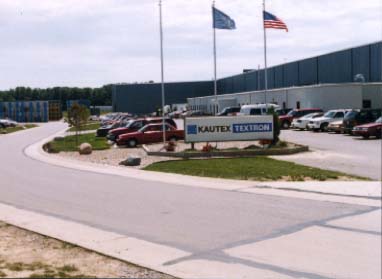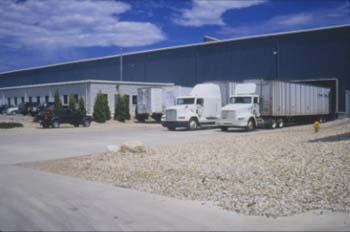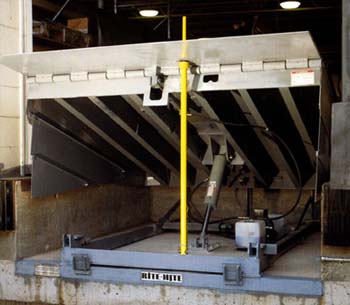Company running on full tank with leveler upgrades
A fuel tank distributor says safety and efficiency are part of the company's foundation of excellence, makes them top loading dock priorities.
Contents:
Loading dock safety
Hydraulic conversion
Paying dividends
Looking at the entire system
The bottom line
Equipment maintenance is a critical component of any smooth-operating distribution center. At a certain point though, equipment replacement becomes necessary due to safety and productivity issues. These prevailing concerns, as well as sound business sense, are what prompted Kautex-Textron, a major manufacturer of plastic fuel tank systems in Avilla, IN, to make across-the-board loading dock upgrades at its distribution facility – upgrades that included new hydraulic leveler conversion kits, vehicle restraints and seals and shelters.
"Excellence has been the foundation of our business since day one," says Doug Stanford, purchasing manager for Kautex-Textron Avilla. "Investing in top-line dock equipment contributes to our company's ongoing commitment to safety and efficiency."
Kautex-Textron Avilla, QS-9000 and ISO-14000-certified, is regarded as an innovative and proactive industry leader. The company shipped close to 1 million fuel delivery systems last year for clients such as Daimler Chrysler, Honda, and Mitsubishi. Seven days a week, 24-hours a day, the 140,000 square-foot production and distribution facility has to be in peak operating condition.

"Since our facility was built in 1993, we've made four additions totaling 85,000 additional square feet for increased production and shipping," says Stanford. "We'll continue to grow, and we'll continue to expect safety and performance throughout our business."
Stanford says it's because of safety and dependability that they specified Rite-Hite equipment for all their dock positions. "Safety's a number one priority on the floor and at the dock," says Stanford. "We train our employees in equipment operation, maintenance and ergonomics to keep accident-prevention on the top of everyone's mind.
When Stanford and others at the Kautex-Textron Avilla facility started to evaluate the existing dock equipment for possible improvements, they first turned their attention to the levelers.
Stanford says that the airbag technology of the levelers made it difficult for fork trucks to service trailers below dock level, and they did not have the full range of safety features they needed.

"We were looking for built-in safety equipment – not to mention ease-of-operation and minimal maintenance," says Stanford. "We wanted levelers that would contribute to the growth of the business."
Back to top
Stanford and the others decided that upgrading to Rite-Hite Aftermarket's Hydraulic Dock Leveler Conversion was the answer to some of their challenges. The cost-effective conversion used the existing leveler structures at the dock positions, the platforms and lips, while converting the mechanical parts of the airbag levelers to hydraulic action with an entire host of operational safety features.

Since the hydraulic conversions are available for practically every make and model of mechanical and power-assisted leveler, matching the appropriate kit to the application was easy and installation at each dock position took less than a day. The kits included all the necessary hardware: the hydraulic power unit, hose and fittings, main cylinder, lip cylinder, pushbutton control for activation and mounting brackets.
In addition to full-range toe guards, the Rite-Hite hydraulics feature velocity fuse free-fall protection. Should a trailer pull away from the dock when a load is on the leveler, the velocity fuse stops the flow of hydraulic fluid in the cylinder. The fluid break is designed to "freeze" the platform within 3 inches of downward travel, thus avoiding a potentially fatal accident.
Back to top
Since maintenance costs were an issue with the airbag levelers, Stanford has paid close attention to the performance of the converted levelers. He has not been disappointed.
"The hydraulics require very minimal maintenance," says Stanford. "We've lowered our overhead considerably, and we're looking forward to this kind of savings for many years to come."
Stanford also sees an increase in productivity from the levelers. Loading large, metal racks of completed fuel tanks into semi trailers with different heights, widths and suspension types is not an easy job. Efficient loading requires ample room for forklift maneuvering, as well as a smooth ramp for forklift travel between the dock and the trailer.
Before the conversion, safety legs on the bottom of the airbag levelers would limit the distance the platform could go down. Designed to provide platform free-fall protection in the event of a trailer departure, the safety legs would bottom out on the leveler frame. The steep slope of the leveler lip to the trailer bed made servicing below-dock trailers a slow and difficult process.
Now, the velocity fuse free-fall feature has replaced the bulky safety legs. In effect, the push-button full-float hydraulics allow the leveler platforms to follow truck beds 12 inches above to 10 inches below dock height. The full-float capability makes it easy for forklifts to service trailers at almost any height.
"Servicing 25 to 30 trailers a day, we can't afford a hold-up," says Stanford. "We can quickly service trucks, no matter what height the trailer bed is at.
Stanford says converting to hydraulics, without having to completely replace the levelers, was a factor in the upgrade decision. "It's a great option," says Stanford, "especially when cost is an issue."
Back to top
In addition to the conversion kits, Kautex-Textron Avilla decided to install Rite-Hite Dok-Lok vehicle restraints and Frommelt seals and shelters at all the dock positions. As with the levelers, safety was a top priority when Stanford examined equipment options.
"Let's face it," says Stanford, "sometimes trailer tires don't get chocked properly, either by truck drivers or employees, and then there's the potential for serious accidents."
The push-button-operated Dok-Lok restraints hold trailers in place during loading and unloading, helping prevent an accident if a truck were to separate from the dock. The restraint's rotating hook design can help keep the trailer upright in case the landing gear should collapse, or if the trailer up-ends due to imbalanced loading.
When a truck backs up to the dock, the forklift operator pushes a button to engage the restraint, and a red flashing light alerts the truck driver of hook-up. Once the servicing is complete, the forklift driver pushes a button to release the restraint, and a flashing green light lets the truck driver know it's safe to pull away.
"In the race to get trailers serviced quickly, we need to make sure our employees are safe," says Stanford. "Choosing Dok-Loks made common-sense."
The Frommelt seals and shelters help prevent dock impact damage from incoming trailers – impact that Stanford says was really beating up the foam and material of the older seals. According to Stanford, the new foam seals sustain trailer impact well, while providing an effective weather seal along the sides and top of the trailer.
Back to top
Evaluating loading dock operations and making necessary equipment upgrades is an important part of maintaining warehouse safety, lowering maintenance costs and boosting distribution efficiency.
"We feel we've made some good decisions here," says Stanford, "for both our employees and our business."
This case study was provided by Rite-Hite Corporation
